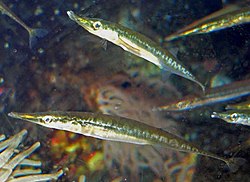Top Qs
Timeline
Chat
Perspective
Aulorhynchus
Genus of fishes From Wikipedia, the free encyclopedia
Remove ads
Aulorhynchus is a monospecific genus of marine ray-finned fish belonging to the family Aulorhynchidae. Its only species is the tube-snout (Aulorhynchus flavidus) which is found off the western coast of North America.
Remove ads
Taxonomy
Aulorhynchus was first proposed as a genus in 1861 by the American zoologist Theodore Gill, when he described Aulorhynchus flavidus, placing it in a new monotypic genus.[2] The type locality is given as the coast of Washington.[3] This genus is included in the family Aulorhynchidae in the suborder Gasterosteoidei of the order Scorpaeniformes in the 5th edition of Fishes of the World.[4]
Etymology
Aulorhynchus, the genus name, is a combination of aulos, meaning "flute", and rhynchus, which means "snout", a reference to the flexible tubular snout of this species The specific name, flavidus means "yellowish".[5]
Description
This species grows to 18 cm (7.1 in) in total length. It physically resembles the sticklebacks, but has a thinner, longer body, with 24 to 27 small spines in front of the dorsal fin.
Biology
Aulorhynchus also possess a slender snout, hence the common name. Like the sticklebacks, it feeds on small invertebrates and fish larvae.[6]
Also, like sticklebacks, it produces a sticky secretion from its kidneys when breeding. Whereas sticklebacks use this secretion to bind plant matter together to create a nest, the tube-snout simply attaches its eggs to a substrate. Aulorhynchus attaches its eggs to kelp,[6] notably Macrocystis pyrifera.
Spawning occurs throughout the year, and males guard nest sites by actively defending them from predators. The nests are found at depths of 10–20 m and have been recorded up to 38 m.[7]
The tubesnout feeds on small planktonic crustaceans, including amphipods, mysids, and crab larvae.
This species finds use as a denizen in public aquariums.
Remove ads
Habitat
The tubesnout is found in shallow marine waters off the Pacific coast of North America to a depth of 30 m (98 ft), from Prince William Sound in Alaska to Rompiente, Baja California. The species inhabits rocky crevices, kelp beds, eelgrass, and areas with a sandy bottom substrate.[7]
References
Wikiwand - on
Seamless Wikipedia browsing. On steroids.
Remove ads


